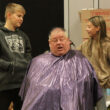Sean C. Morgan
“Another recruit coming up here,” called out Gifford Pinchot, the first chief of the U.S. Forest Service, as he stood outside the dispatcher’s cabin at Fish Lake. “We signed up another recruit!”
Pinchot, portrayed by Sweet Home Ranger District Archaeologist Tony Farque, was on hand with Archie Knowles and other historic U.S. Forest Service figures for the Willamette National Forest’s centennial celebration held July 20 at Fish Lake, an important historic site for the Willamette forest.
“President Roosevelt couldn’t make it, but he sent me on his behalf,” Pinchot said.
Inside the tiny dispatcher’s cabin, one of those figures, Cy Bingham, a ranger around the time that the national forest system was formed, gave tours. He was portrayed by Steve Coady, formerly of the Forest Service.
At around the time the forest was created, recruits would face one day of written tests, Coady said. The second day had a chopping test outdoors, where a good ax man was measured by the size of his chips. The recruits had to be proficient with a pistol at 25 yards and a rifle at 100 yards. Supplies would be laid out on a tarp, and recruits would have to demonstrate a proficiency turning it into a pack.
Initially, the Forest Service used ex-cowboys, mountain men, miners and general wanderers to serve as rangers, Coady said. The rangers stayed out in the forests through the rain and snow at $60 per month. The pay was acceptable, but they had to buy their own horses.
“The only thing the government bought was the badge,” Bingham (Coady) said. “We didn’t like the confined city life.”
Worried that the wilderness was disappearing, Pinchot and President Theodore Roosevelt set aside the national forests for fishing, hunting and recreation.
“I was the ranger up here for a few years,” said Archie Knowles (Brett Blundon, a fish biologist with Sweet Home Ranger District). He was stationed around Davis and Crescent lakes and Smith Prairie just south of Fish Lake from 1908 to 1912. “I was one of the first Oregon rangers – mostly known for doing tricks off the backs of horses.”
The historical figures spent the day greeting Forest Service employees, retirees and guests. Forest Service employees demonstrated 100-year-old wood cutting techniques and tools, many of which remain in use today on the wilderness areas. The Confederated Tribes of Grand Ronde showed Native American artifacts and demonstrated various techniques for living on the forest. The Sand Mountain Society had a display explaining its work restoring fire lookouts.Visitors could visit different buildings, and they enjoyed a barbecue lunch with music.
The celebration actually celebrated the formation of the Santiam National Forest, which was formed in 1911, said Cathy Lindberg, a Forest Service Archaeologist based in Springfield. In 1933, the Santiam was combined with the Cascade National Forest to create the Willamette National Forest.
The Forest Service had planned the centennial celebration for last summer but canceled it due to a large fire in the area that kept officials too busy.
The Santiam National Forest covered roughly the same area as the Detroit and Sweet Home ranger districts, although there was a little overlap with the McKenzie, Lindberg said. Fish Lake, which is now in the McKenzie Ranger District, was in the Sweet Home Ranger District.
During the big timber boom of the 1950s, the forest was broken into smaller districts because the Forest Service was so busy, Lindberg said.
Fish Lake, located off Highway 126 about 4 miles east of the junction of Highway 20 and Highway 126, sat near a crossroads, Native American trails east and west, which became the Santiam Wagon Road, and north and south, which became the Pacific Crest Trail.
The Molalla tribe made its living trading in all directions, hunting and fishing in the area, said David Lewis, manager of the cultural resources department for the Confederated Tribes of Grand Ronde. The Santiam and Calapooia tribes also were in the area.
The natives used canoes to travel the rivers and fish, he said. They would harvest huckleberries, cedar and other plants in the area, and they hunted deer and elk.
Fish Lake was first used by the Forest Service as a ranger outpost in 1905. In the 1920s, it served as the field and dispatch headquarters for the Santiam National Forest. The forest supervisor lived at Fish Lake during the summers in the 1920s. Then it was used as a remount and supply depot until 2005. The last packer, Betty Applebaker, who served there from 1985 to 2005, demonstrated her mule pack train during the celebration.
The remount depot served as a field officer where Forest Service personnel could rest their pack animals and stock up on supplies. Pack animals typically carried food, tents and field gear.
Retired Forest Service employees have formed a group, Friends of Fish Lake, to preserve the site.
Their aim is to restore and maintain it, said Rolf Anderson, who was Sweet Home District Ranger from 1992 to 1998. He also worked in Sweet Home from 1965 to 1966 as a timber management assistant for Bud Baumgartner.
The group has restored several buildings and hosts regular work parties to keep up on the compound, Anderson said. The group has a long-term vision of building a training center there.
Many of the buildings were constructed in the 1920s, Anderson said. The Civilian Conservation Corps built the blacksmith shop in the 1930s. The bunkhouse was added in the 1950s when the forest was actively logged.
For more information about the Friends of Fish Lake, visit fishlakehistoricsite.org. The group is seeking volunteers and support.
Fish Lake is open to the public. Call McKenzie Ranger District (541) 822-3381 or Sweet Home Ranger District at (541) 367-5168 for more information.




